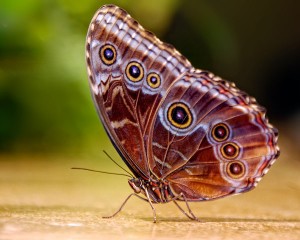Butterflies and Biomimicry

Originally appears in the Spring 2013 issue
“Biomimicry is the science and art of emulating Nature’s best biological ideas to solve human problems.”[i] Humans have been using biomimicry for thousands of years, but only recently have we started to re-learn how nature solves problems. By using nature as a model we can create more efficient systems that have been proven to work through evolutionary time. This article will introduce biomimicry to students through activities that examine the unique properties of the wings of Morpho butterflies and how they can help us solve human problems. If we could learn to mimic the Morpho’s ability to create physical iridescence, we could solve the problem of making environmentally friendly dye free paints, fabrics, cars, and electronic displays for cell phones, computers, and TVs. It has even been proposed that this technology could be used to make currency with anti-counterfeit technology that would be difficult to replicate.
Most people are unaware of the fact that butterfly wings are actually transparent. They are covered in tiny delicate scales that give them their coloration. When a butterfly wing is touched the scales can fall off. They do not re-grow scales once lost, and while removal does not hurt the butterfly, it does inhibit flight. Scales act as waterproofing. They also keep the wings aerodynamic, and are also useful for absorption of light, communication, keeping warm, and as a colorful warning to predators. The color of the scales comes from melanin for browns and blacks, while greens, blues and reds and iridescent colors are caused by the scattering of light by the shape and structure of the scales.
To view the photo-rich magazine version, click here.
If you are not already a subscriber, please subscribe to read the full article
Karen McDonald is the Education Outreach Coordinator for the Smithsonian Environmental Research Center in Edgewater, Maryland. In her spare time, she develops educational models in an effort to promote a strong interest in biomimicry and learning from nature.
[i] Biomimicry Institute, 2009. <biomimicryinstitute.org>
Leave a Reply
You must be logged in to post a comment.





